Doctor Goodwin’s Ghosts
A Tale of Midnight and Wythe House Mysteries
by Ivor Noël Hume
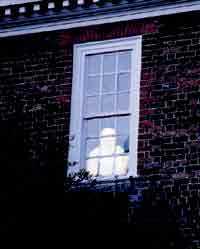
The Reverend Dr. W. A. R. Goodwin, the clergyman usually given credit for the idea of Colonial Williamsburg, once told newspaper columnist Ernie Pyle, “I wouldn’t give a hoot for anybody who doesn’t believe in ghosts.” That was in 1936, while Pyle was visiting Williamsburg’s Restoration. He liked Goodwin—a pipe-puffing, quiet-spoken and disarmingly engaging cleric who could charm birds out of trees and money out of misers. But Pyle seemed surprised that the city’s leading minister believed in ghosts, and one suspects his remark was a joke that he had used in many another context.
But could Goodwin really have put stock in spirits? And, if he did, was there something out of step with theological doctrine in the proposition that souls supposed to be safely in heaven were wandering the streets of Williamsburg talking to the parish priest about terrestrial history? Pyle wrote that it was when Goodwin “was alone, in the starlight, strolling in the night, talking with the ghosts, that he learned about Williamsburg.”
Goodwin’s ghosts were not of the headless-horseman, chain-rattling, Dickensian variety. No, they were sufficiently benign for him to write to ten-year-old Joan Scott of Norfolk that you can “shut your eyes and see the gladsome ghosts who once made these places their home. You can learn to call them back,” he said. “You can train yourself to hear what they have to say.” That was in 1927, but the seeds of Goodwin’s belief were much older.
In 1905, he undertook a restoration of Bruton Parish Church that led to replacement of the floor and explorations among the graves beneath it. His daughter Evelyn recalled “digging down to the coffins” as his partner “in this archaeological work.”
“My father with his inspired understanding realized
that skeletons and coffins might frighten a child, so he constantly
talked of life, of noble deeds of bygone days, and of Jesus and
the open tomb. As I look back,” Evelyn said, “I can see
how he taught me then the priceless truth of immortality.”
From these, as well as other statements by Doctor Goodwin, we might
conclude that his ghosts were the product of his imagination and
had nothing to do with parapsychology. He simply enjoyed exercising
that imagination and used his ghosts as a metaphor for the vicarious
pleasures to be derived from walking in the footsteps of history.
That conclusion is the logical and certainly the comfortable interpretation.
Indeed, in none of his letters or speeches did he discuss his ghosts
in terms of the supernatural. Yet, with that said, one cannot quite
be sure.
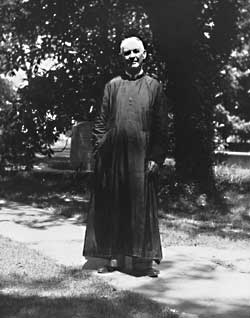
The Reverend W. A. R. Goodwin
spoke often
of Williamsburg' ghosts when he served the Restoration as local
director in 1920s and 1930s.
- Colonial Williamsburg
In 1936 he wrote to an inquirer from Pittsburgh answering her question about the ghosts she had heard haunted the Parish House—now the George Wythe House on Williamsburg’s Palace Green—where Goodwin had his office. Built about 1750, it stands just north of Bruton Parish Church and its burial ground.
Legends had it that the hauntings involved as many as three ghosts. Goodwin’s correspondent wanted descriptions. He said “they are very elusive ghosts and refuse to be delineated or described within the limits of any paragraph. The only way,” he told Miss Gibbs of Pittsburgh, “is to come here and hold communion with them.”
More than sixty years later I decided to accept that invitation and to sit in Dr. Goodwin’s Wythe House office at midnight and wait for something to happen. Why midnight?
“Tonight,” Goodwin wrote in 1935, “I am in the Wythe House waiting for the hour to strike for the midnight Christmas-Eve service. . . . One is not alone here. The Ghosts of the past are my gladsome companions in the near midnight silence.”
Midnight has always enjoyed an eerie and melancholy reputation. In 1632 poet John Milton put it this way:
Hence, loathèd Melancholy,
Of Cerberus and blackest Midnight born,
In Stygian cave forlorn,
’Mongst horrid shapes, and shrieks, and sights unholy.
Longfellow wrote of “the mournful midnight hours,” Shakespeare of his “secret, black, and midnight hags,” and an old English music hall song told how, with her head tucked underneath her arm, the ghost of Anne Boleyn walked the Bloody Tower at the midnight hour. There is no doubting that midnight has an ancient reputation as a good time for bad things. But would it run true to form when Colonial Williamsburg photographer Dave Doody; Tanya Wilson, curator of historic interiors; and I set ourselves up in the Wythe House on the night of December 14 in the year 2000?
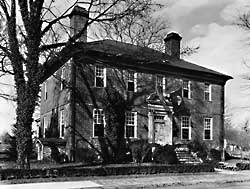
Goodwin made his headquarters on the second floor of the Wythe House. , said by some to be haunted. -- Colonial Williamsburg
Before we get to that, I should outline my ghost-hunting credentials. A series of experiences in England in the 1940s left me a believer. Indeed, I could hardly have done otherwise. It’s not every day that one is driven out of a rented house after only four nights—four nights of lamps suddenly extinguished, doors that unlatched and slammed shut of their own accord, a light on a ceiling that came from nowhere, and a shape at the end of my bed that refused to vanish until I threw a candlestick at it. Then there was the theater that caught on fire . . . but that’s another story. Suffice it to say that I had sufficient reason to believe that Hamlet was right when he told Horatio that there were more things in heaven and earth than were dreamed of in his philosophy.
In the 1950s my duties as Colonial Williamsburg’s archaeological director included giving a monthly evening lecture to weary-footed visitors. In an effort to get past the popular conviction that archaeology consists of little else than digging up old potsherds and measuring them, I tried to get across the idea that the shards are the legacy of human activity, and that by being the first to touch them in the ground one is in direct contact with the last person who held or dropped them. Unaware of Doctor Goodwin’s means of evoking the past, I summoned up my own eighteenth-century ghost to watch us as we dug, and used him to good effect through all the years that I gave the lecture. Maybe he lingers still in the field beside the Anthony Hay Cabinet Shop.
It was also in the 1950s that my archaeological association with the Wythe House brought me close to becoming its fourth ghost. While excavating about thirty feet down in its well shaft, I pulled out a timber I thought lay in solid fill only to discover that it was the last support between me and a plunge into the water ten feet below. My bucket, several more timbers and a cascade of fill dirt splashed down, leaving me clinging spider-like to the side until a rope could be lowered. I would never again excavate in a well without a safety line about my waist.
The memory of that terrifying moment came back to me as Tanya, Dave, and I prepared to enter the Wythe House shortly after eleven on a chilly December night.
I knew enough about psychical investigation to know that any hope of capturing a Wythe House ghost on camera would call for infrared film that might pick up an emanation in the dark that would never record on regular film. Dave had a roll in his magazine.
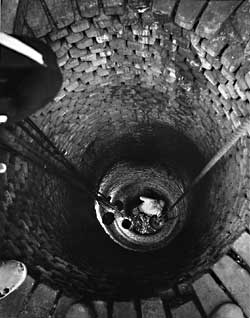
Contributor Ivor Noel Hume at the bottom of a Wythe House well much like the one in which he was trapped. --Ivor Noël Hume
Because most such vigils are generated by trying to prove or disprove the legitimacy of a recently recorded psychical experience, an investigator’s first step is to minimize opportunities for fraud. Doors and windows are sealed with marked tape, and hair-thin threads are stretched across staircases and interior doorways. But we had no need of such precautions. No one was attempting to exploit the house’s reputation and recent reports of supernatural occurrences were few and vague. There was talk of a cold spot upstairs in the room that had been Dr. Goodwin’s office, but every allegedly haunted house has one of those, and most can be ascribed to drafts from loose windows. In the case of Borley Rectory—The Most Haunted House in England—the chill came from a ventilation duct that on windy days blew cold air under certain floorboards.
But what about the reported tap, tap, tapping of a foot on the Wythe House stairs? Expanding joints between the treads? Old houses always creak, particularly those like the Wythe House whose stairs are in constant use by visitors and interpreters. Logical explanations are always reassuring, but sometimes there are none. And no one has proved that the tapping is caused by anything or anyone other than the ghost of Anne Skipwith who some have said committed suicide and lies buried in the next yard, the Bruton Parish Churchyard. This is her story:
Of Scottish descent, Anne was the wife of Sir Peyton Skipwith of whom little is known except that he lived on his plantation in distant Mecklenburg County and, when the courts were in session, came to Williamsburg to lodge at what is now the King’s Arms Tavern. A French visitor staying there in 1765 found himself in the company of Skipwith as well as Colonel William Byrd and others who the Frenchman described as “all professed gamesters” who were never happy without dice in their hands. Sir Peyton took other risks, among them an alleged affair with Jean, his wife’s sister. While attending a ball at the Governor’s Palace down the street, Lady Anne had a violent altercation with her husband and in a fury fled from the ballroom, ran across Palace Green, losing a shoe in her haste. Arriving at the Wythe House where she was staying, she ran up the stairs to her room still wearing the remaining shoe.
Author L. B. Taylor Jr., in his recent book The Ghosts of Virginia, discussed the Wythe House haunting and wrote that, “The most frequent occurrence, almost always at midnight, is the distinct clicking sound of one high-heeled slipper on the shallow steps of the broad stairway. Yet when the stairs and upstairs rooms are searched, no one is ever found.” The narrative starts the hairs rising on the nape of one’s neck, until one asks just who in the world would be in the closed-up Wythe House at midnight to hear the tapping and then bravely follow it up the stairs to confront the tapper?
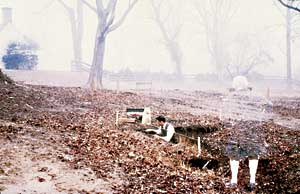
The author, Colonial Williamsburg's former archaeological director, used this ghostly image in the 1950s to enliven evening lectures. --Ivor Noël Hume
Although there is no proof that Lady Anne did not get into a spat with Sir Peyton at the Governor’s Palace, she did not commit suicide. She died in childbirth. Nor is she buried in Bruton Churchyard. Nevertheless, Sir Peyton Skipwith did marry her sister—which could well have made her ghost hopping mad. But would she hop and tap for Dave and me? That was what we were there to find out.
Questions put to the Wythe House’s interpretative staff had elicited responses sharp and unequivocal. Almost as one, they answered, “There are no ghosts in the Wythe House, and there never have been.”
A senior interpreter unbent sufficiently to express a frustration: “Far too many visitors come to the house and ask about the ghost” she said. “That’s all they are interested in.” I could well appreciate her exasperation at having to waste time politely answering so puerile a question when the story she has to tell is that of George Wythe as a Signer of the Declaration of Independence and a major influence on the minds of the nation’s founders. On the other hand, one might cautiously argue that if it takes a ghost to attract a visitor through the door to hear about Wythe, then such a spectral propellant has its uses. That, undeniably, was Doctor Goodwin’s attitude, and one can imagine his own wraith materializing in a cloud of tobacco smoke to denounce those who insist that there are no Wythe House ghosts.
In an unguarded moment, another interpreter divulged that only a few weeks before, a visitor reported sensing a woman bending over a trunk in one of the upstairs rooms. My informant said in a derisory tone “How could anyone sense something like that?” In truth, however, most reported encounters with the paranormal are impressionistic rather than dimensionally robust. You sense someone is behind you. You turn and find that they are. Your mind has received the message ahead of your eyes, ears, or nose.
A strong aroma of perfume has its place among the Wythe House’s files. In 1986 or thereabouts, an employee keeping track of visiting groups was sitting on a chair at the back of the hallway when she smelled perfume and concluded that someone in a current group of visitors had been wearing it. Her clipboard notes recorded, however, that the last group had left the house twenty minutes earlier. It was, she said, as if someone wearing strong perfume had leaned over her shoulder to read the clipboard.
A second perfume sensing was reported in March 1999 when an evening interpreter said she heard chairs being dragged about in the empty parlor and smelled perfume as she stood in the open front doorway.
In several instances, tales of supernatural encounters in the Wythe House have been recorded only after assurances of anonymity, presumably because the teller feared the derision of his or her colleagues. In 1987 one such informant told of blue lights seen from inside the building after closing; another of “a scowling gentleman in eighteenth-century clothes” walking up and down outside the room now shown as Mr. Wythe’s library. And then there was the visitor who fainted dead away after watching a woman pass through the bedchamber over the parlor and leave through the wall by the closet.
That Doctor Goodwin did not deny that there could be as many as three ghosts haunting the Wythe House becomes more understandable the deeper one digs. But, like the questionable Lady Skipwith, not all stand up to historical scrutiny. The story of Wythe’s faithful slave Lydia being murdered at about the same time that Wythe was poisoned in Richmond, and that she has been seen waiting for him at his Williamsburg home, is readily disputed. An interpreter who plays the role of Lydia today assured me that nobody murdered her and that, instead, Lydia went to Richmond with Wythe where she made her will in 1820 and died about five years later. It is, alas, a ghostly characteristic that once we endow spirits with specific names and dates, they are wafted away in a gale of skepticism.
Should we conclude, therefore, that if there are ghosts at the Wythe House, they are drawn only from the ranks of the white gentry?
I think not.
About twelve years ago when my stepdaughter Andi worked as a facilitator
for Colonial Williamsburg’s ever-popular evening lantern tours,
her tasks included preparing the Wythe House kitchen. One night when
she was setting lighted candles in the windows, she heard heavy footsteps
upstairs and went to see whose they were. The rooms were empty, but
almost immediately the footsteps resumed below. Down went Andi, but
again there was no one—but the candlestick at the window had moved
to the central table. While she stood trying to figure out what had
happened, the exterior door opened, but no one came in. When at closing
time she went back to the kitchen’s upper room, Andi found that
the candle in that window had been moved to a table. Footsteps can be
dismissed as naturally creaking boards and an opening door attributed
to a sudden gust of wind, but peripatetic candlesticks are harder to
explain. For Andi, no temporal rationale would be sufficient for her
to ever again work a night shift at the Wythe House kitchen.
While Andi was setting up in the kitchen that night, a fellow employee
was doing the same at the Harness Shop on the other side of Prince George
Street. She chanced to look back up the road to the kitchen at the moment
that the candle was being moved away from its attic window.
Interviewed for this article she told how, when her turn came to prepare
the kitchen for the evening program, she would find a presence playing
games with her, alternately opening and shutting the door and outside
gate. The kitchen, she said, is one place she’ll never enter alone
after dark.
Having said that, legitimate skepticism must allow that one such story
can breed a dozen others. A wind-blown door, a tree-cast shadow, a voice
from someone passing in the street, easily translate into unwarranted
terror.
Just as slave Lydia’s name cannot be linked to my stepdaughter’s experience, so no name attends the best documented of recent psychic encounters at the Wythe House—nor do I think it necessary to name the witness who graciously led me to the place where it happened and who responded to my interrogatories with such patient good humor.
About twelve years ago a young interpreter opened the understairs door leading to the Wythe House basement employee break room when she felt pressure behind her knees that compelled her to sit on the top step. She recalls no sense of fatigue or illness, nor did she consider the bare wooden step a strange place to sit. It seemed a natural thing to do.
Sitting slightly turned to her left, she saw what she describes as a mirror reflecting not her own seated figure, but that of another woman who, like herself, had red hair. With her mind accepting that she was indeed seeing a reflected image, the interpreter turned to her right and found the red-haired lady sitting beside her on the step. The ghostly figure smiled and faded away into the white-painted brick wall. The young interpreter felt neither fear nor surprise. On the contrary, it was not until she had completed her break that she looked to be sure that there was no reflective surface on the wall that could have mirrored and distorted her own image. When, on the night of my vigil, I sat on the same step it was abundantly clear that it was not wide enough to accommodate two people.
There being no reason to doubt the truth of the interpreter’s account, we are left groping for some rationale to explain so unusually close an encounter with what psychics like to call the spirit world. As a rule, reported ghosts do their own thing, be he the scowling man pacing outside George Wythe’s library or the woman inspecting an antique trunk. They come and go as they please, are sighted by only by a handful of people, rarely more than one at a time, and go unseen for extended periods. If, however, we lay skepticism aside long enough to focus on this now-you-see-me, now-you-don’t factor, it makes sense to deduce that it is not the ghosts who come and go, but rather the absence of people whose minds are tuned to a wavelength able to sense their presence. If that be true, Doctor Goodwin’s ghosts really were all around him as he so often insisted.
So what was it that prompted the ghost to reach out and urge this young Wythe House interpreter to sit with her on the stairs? Was it that they were of similar age, were of comparable emotional character, or was it, perhaps, that both had red hair?
Years later the interpreter told her story to another Colonial Williamsburg employee. He said that he, too, had had a Wythe House experience, not inside but out. At about ten o’clock on a Friday evening in the fall of 1994, the young man, along with a male friend and a girl who claimed psychic instincts, decided to visit the Wythe House on a lark, and, while standing on its garden-facing steps, to summon up the ghost of Anne Skipwith. The girl quickly decided that the game was not funny and wanted to leave—which they did. But on reaching the Bruton churchyard wall my informant felt drawn to turn back toward the house. He saw a woman wearing a white shift looking out from the second floor’s southeast window. All three friends saw her. Furthermore she appeared to see them before either fading away or moving aside from the window. When I asked whether the woman had red hair, he said he could not remember, but that he was never likely to forget the night when a psychic game ceased to be amusing.
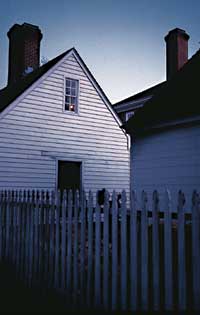
At the Wythe House Kitchen, candles, it is said, sometimes travel from window to table without corporeal help. -- Dave Doody
Just a minute. If this happened at night, how could he see that her shift was white, or even that the figure was that of a woman? “Ah,” say the psychics, “because he sensed that it was—just as he sensed that she was standing at the window.”
Researching the Wythe House’s credentials for being The Most Haunted House in Williamsburg, interviews with other old employees and long-time local residents unearthed a plethora of ghostly stories that ranged from a woman who passed through a railing to apples that flew off a Christmas decoration and the inevitable footsteps and doors that opened and closed of their own volition. But this—I had to keep reminding myself—is a Wythe House story.
Dave Doody, Tanya Wilson, and I arrived at 11:30 on a night milder
than the forecast icy-rain and under a sky of broken cloud. Once inside,
Tanya called the security department to advise that we were there. The
duty officer told her: “Rather you than me.” He said that
when it was his turn to patrol the building he got in and out as fast
as he could. He had sensed a presence on the stairs.
Standing in the darkness at their foot, I could well believe it. Two
small patches of moonlight cast through the transom over the front door
left a vertical bluish-gray streak between them that waxed and waned
as clouds moved across the sky. That impression vanished as soon as
Tanya lit a hallway candle whose flickering flame cast its own shadows
up the staircase wall.
Meanwhile, with a powerful, ghost-dispelling flashlight, I helped Dave
unpack his photographic equipment. That done, I set myself up in the
second floor’s southwest room and by the light of a single candle
began to write down everything I saw and heard. It was fifteen minutes
to midnight.
At 11:55 I heard a faint and eerily wailing sound—the voice of
a distant ambulance speeding about its business on the other side of
town. All else was silence save for the hum of the heating system. Its
ceiling-fed air was causing my candle to waver in fluctuating spasms.
Shadows of chair backs moved from side to side along the white walls.
And somewhere in the darkness beyond the open door I could hear movement.
But whether it was Dave setting up or Tanya moving about the building.
. . .
I persuaded myself that it had to be one or the other.
Downstairs in the parlor Dave was standing in the darkness considering how best to set up his infrared camera when he saw a pale white shape in the corner. It became clearer as his eyes grew accustomed to the dark. It was a ceramic teapot on a cupboard shelf. It seemed to be alive with light. But it gave off none, leaving the other tea wares on the shelf in deep darkness. Of the ghostly experiences in the Wythe House, the ghostly teapot would cap them all—and Dave was there to record it on film.
Alas, there was a simple explanation. A small, circular peephole in the closed shutters let in a soft shaft of moonlight that fell on the teapot.
At my station upstairs, I was unaware of Dave’s teapot drama. I had expected that somewhere in the house a clock would strike the midnight hour, but none did, and it was five minutes after before I again checked my watch. The plan was to remain in the house for another hour, and so I decided to first make my way down to the basement for a cup of adrenaline-boosting coffee. My all-powerful flashlight would show me the way. But when I switched it on, nothing happened. Its brand-new battery was dead.
Shortly after returning from the basement—aided by Tanya’s flashlight—and settling back onto my chair, I felt a slowly growing chill down the back of my neck. Don’t move, I told myself. Let whatever is happening, happen.
Nothing did. The thermometer in the room continued to read 71o F, and I had to conclude that the sensation was the product of body heat elevated by the coffee in conflict with draft from the heating system. Remembering my stepdaughter’s experience in the Wythe kitchen, I sat staring fixedly at the candlestick willing it to move. It was now 12:45 a.m.
“If nothing happens in the next fifteen minutes,” I wrote in my journal, “the spirits will have missed their golden opportunity, and the folks who have insisted that there are no ghosts in the Wythe House will nod sagely and say to each other, ‘We told him so.’”
At 12:50 a.m. I wrote: “Time to pack up and leave the ghosts to
their own amusements—at our expense.” And so we did, remaining
only long enough for Tanya Wilson to close the silent building. When
she got up to go to work that morning, her car wouldn’t start.
Its battery was dead.
The next day, a lifelong resident of Williamsburg now in her eighties
called to ask how we had fared in our vigil. When I confessed that nothing
had happened, she said “Of course not. You can’t expect anything
like that to happen to order, and certainly not with a photographer
around. I know there are ghosts,” she said. “You should try
again—but do it on your own.”
I don’t think so.
Author Ivor Noël Hume, who contributed “Mentioning the Unmentionable” to the winter journal, is indebted to curator Tanya Wilson and to all those present and former Colonial Williamsburg employees who shared their experiences with him. He has, by the way, recently completed the draft of a book on the history of ghosts titled Digging in the Dark, and is looking for a publisher.
